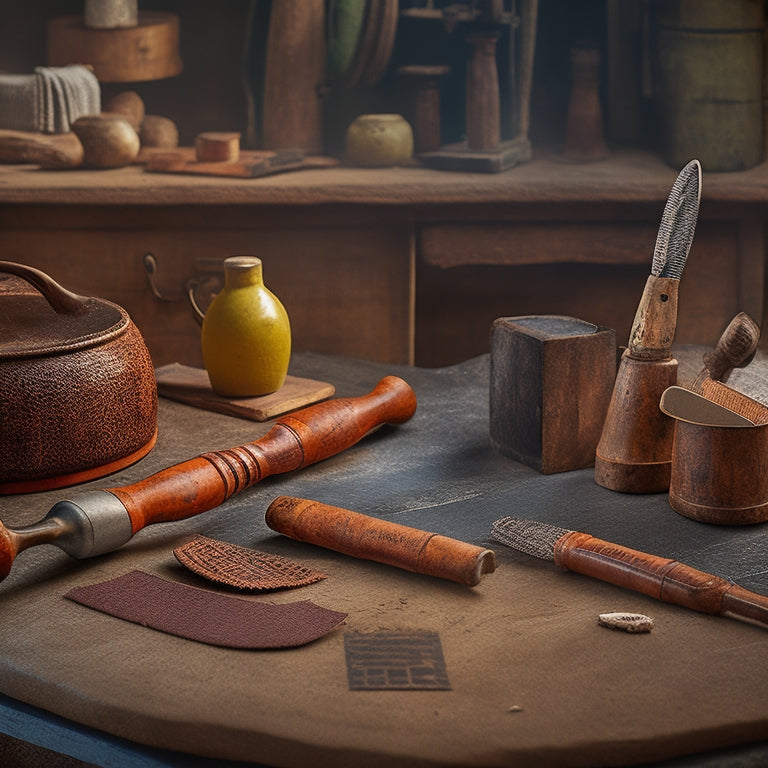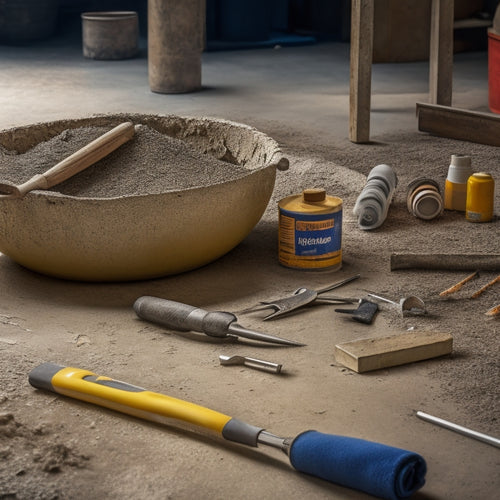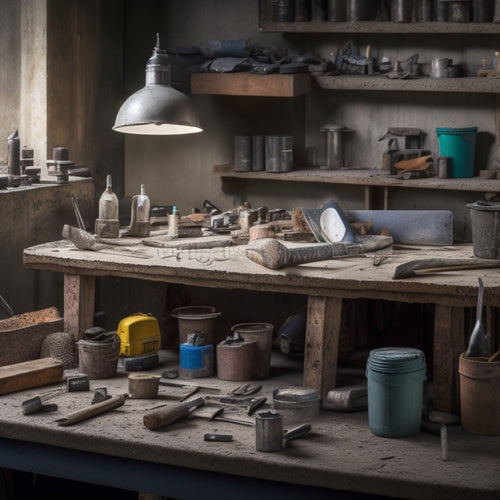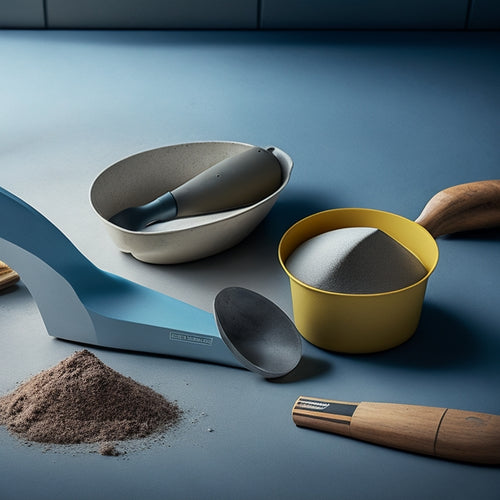
Top 3 Stamping Tools for Decorative Concrete Success
Share
You'll increase your chances of achieving decorative concrete success by 80% simply by investing in the right stamping tools, with the top three essential tools being a high-quality stamp mat, a reliable tamper, and a versatile concrete stamper. A high-quality stamp mat serves as the foundation for your pattern design, while a tamper guarantees even pressure and a level surface. Meanwhile, a concrete stamper provides design flexibility for complex patterns and allows for intricate designs and custom textures. By mastering these tools, you'll unleash the full potential of your decorative concrete projects and discover the secrets to creating truly exceptional designs.
Key Takeaways
• A high-quality stamp mat serves as the foundation for pattern design, ensuring a strong base for decorative concrete projects.
• A tamper is essential for applying even pressure and creating a level surface, resulting in uniform texture and pattern.
• A Fresno/tamping tool helps achieve consistent density and texture, adding realism to decorative concrete designs.
• An edger/margin trowel is necessary for creating crisp, clean lines and defined edges in patterns and designs.
• Regular tool maintenance, including cleaning and storage, extends the life of stamping tools and ensures optimal performance.
Essential Tools for Pattern Creation
You'll need a set of essential tools to create intricate patterns and designs on your decorative concrete, starting with a high-quality stamp mat. This mat will serve as the foundation for your pattern design, allowing you to achieve the desired texture and visual appeal.
In addition to the stamp mat, you'll need a tamper to guarantee even pressure and a level surface. A fresno or tamping tool will help you achieve a uniform density, while an edger or margin trowel will assist in creating crisp, clean lines.
Proper tool maintenance is vital to extend the life of your equipment and guarantee consistent results. Regularly clean your stamp mat with a mild detergent and water to prevent the buildup of debris and staining. Store your tools in a dry, protected area to prevent rust and corrosion.
Stamping Mats for Texture Variety
As you expand your decorative concrete repertoire, selecting the right stamping mats becomes vital for achieving varied textures that elevate your designs and set them apart from others.
With a wide range of stamping mats available, it's important to understand their unique characteristics and applications. You'll want to take into account mats with different texture techniques, such as rock, stone, and wood patterns, to create unique and realistic designs.
Additionally, mat maintenance is vital to guarantee ideal performance and extend the lifespan of your mats. Regularly clean and store your mats properly to prevent damage and maintain their texture quality.
When choosing stamping mats, reflect on the specific design you're trying to achieve and the type of concrete you're working with. For instance, if you're creating a stone pattern, you'll want a mat with deep, aggressive texture to achieve a realistic look.
By selecting the right stamping mats and mastering various texture techniques, you'll be able to produce high-quality, unique designs that showcase your expertise in decorative concrete.
With the right tools and techniques, you'll be able to take your projects to the next level and leave a lasting impression on your clients.
Concrete Stampers for Versatility
Concrete stampers, with their versatility and adaptability, offer a wide range of design possibilities, allowing you to achieve complex patterns and textures that would be difficult or impossible to replicate with traditional stamping mats. These stampers provide design flexibility, making them ideal for multi-pattern applications. You can use them to create intricate designs, layer patterns, or even create custom textures.
| Pattern Type | Stamp Size | Recommended Use |
|---|---|---|
| Brick | 12" x 12" | Small to medium-sized areas, accent walls |
| Stone | 18" x 24" | Large areas, walkways, driveways |
| Wood Plank | 24" x 36" | Long, narrow areas, borders, edging |
With concrete stampers, you can achieve a high level of realism, making it difficult to distinguish between stamped concrete and natural materials. They're also easy to clean and maintain, ensuring that your tools remain in good condition for your next project. By incorporating concrete stampers into your toolkit, you'll be able to tackle a wide range of projects, from residential to commercial, and deliver high-quality results that exceed your clients' expectations.
Frequently Asked Questions
Can I Use a Single Stamping Tool for Multiple Pattern Designs?
You can achieve pattern versatility with a single stamping tool, but it depends on your tool selection; some tools are designed for specific patterns, while others offer adaptability, allowing you to create multiple designs with one tool.
How Do I Prevent Stamping Tools From Sticking to Concrete?
To prevent stamping tools from sticking to concrete, you'll want to select tools made from materials with low friction coefficients, such as polyurethane or silicone, and apply anti-stick coatings like release agents or powders to guarantee a smooth release.
What Is the Ideal Temperature for Using Stamping Tools?
You'll achieve best results when you use stamping tools within the ideal temperature range of 50°F to 90°F (10°C to 32°C), as temperature effects can greatly impact tool performance and concrete bonding under these ideal conditions.
Can I Use Stamping Tools on Freshly Poured or Set Concrete?
You shouldn't use stamping tools on freshly poured concrete, as it's too soft and vulnerable to damage; instead, wait until it's set enough to support your weight, then apply stamping techniques to achieve the desired pattern on the fresh concrete.
How Do I Clean and Maintain My Stamping Tools After Use?
After each use, you'll need to thoroughly clean your stamping tools with mild cleaning solutions to prevent concrete residue buildup, then store them in a dry, protected area, such as a tool storage box, to maintain their quality.
Conclusion
You've got the skills, now get the right tools to take your decorative concrete game to the next level!
Don't be a medieval stonemason, stuck in the dark ages of concrete design - arm yourself with the top 3 stamping tools for success.
With these essentials, you'll be churning out masterpieces like a modern-day Michelangelo, bringing textures and patterns to life in no time.
Remember, in the world of decorative concrete, the right tools can make all the difference between a mediocre mess and a work of art.
Related Posts
-

Top Tools for Repairing Cracked Concrete Surfaces
When tackling a cracked concrete surface repair, you'll need the right tools to guarantee a durable fix. Start with e...
-

Top Tools for Concrete Repair Success
When it comes to concrete repair success, you'll need a well-stocked toolkit with essential hand tools like trowels, ...
-

Ergonomic Concrete Tools for Tight Spaces
When you're tackling concrete work in tight spaces, ergonomic tools are your best bet for comfort and efficiency. The...


